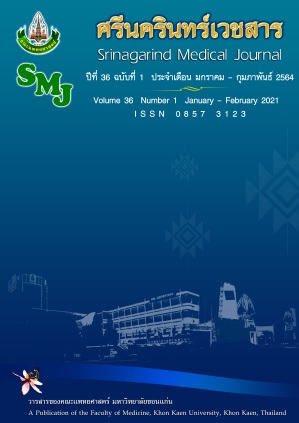Methadone maintenance treatment
Keywords:
opioid dependence, methadone maintenance treatment, withdrawal syndrome, patient adherence, MotivationAbstract
Opioid substitution therapy (OST) is the cost effective method to prolong retention rate, decrease drug dependence, prevent HIV transmission, promote health and wellbeing and decrease crime. Methadone maintenance treatment (MMT) is the treatment program that involves the long-term prescribing of methadone as an alternative to the opioid. It is the most effective treatment among OST. The long-term objective is drug abstinence. Inclusion criteria for treatment in many countries are similar including age of 16-18 years, failure from previous methadone therapy, having motivation. However, the differences are method of drug use, history of treatment and duration of opioid dependence. The exclusion criteria focuses on methadone contraindication. The inclusion criteria of Thai treatment guideline is less strict resulting in more patient access. But the dose of methadone using in Thailand is lowest among countries so the withdrawal syndrome and negative treatment outcome may occur. Duration of treatment is about 1 year similarly in all countries. Treatment outcome was monitored regarding withdrawal syndrome, side effects, and toxicities. The most influencing factor for treatment outcome is patient adherence and the health care professionals have the great impact. Motivation for treatment is the important strategy and treating soon after diagnosis is recommended to enhance treatment success.
References
2. พันธุ์นภา กิตติรัตนไพบูลย์,สุจีระ ปรีชาวิทย์. แนวปฏิบัติการตรวจค้นหาและดูแลรักษาหญิงตั้งครรภ์
ที่ใช้สารเสพติดหรือมีความผิดปกติพฤติกรรมใช้สารเสพติด: ศูนย์วิจัยปัญหาสุรา 2562 [cited 2563 28/04]. Available from: http://www.who.int/substance_abuse/publications/pregnancy_guidelines/en/.
3. อังกูร ภัทรากร, วรพงษ์ สำราญทิวาวัลย์, สรายุทธ์ บุญชัยพานิชวัฒนา, ธวัช ลาพินี, อดิศักดิ์ งามขจรวิวัฒน์, วีรวัต อุครานันท์, et al. มาตรฐานการบำบัดด้วยเมทาโดนระยะยาวของประเทศไทย: โรงพิมพ์แห่งจุฬาลงกรณ์มหาวิทยาลัย, 2556.
4. อภิศักดิ์ วิทยานุกูลลักษณ์, ชีวนันท์ เลิศพิริยสุวัฒน์, อภิชาติ เรณูวัฒนานนท์, ชัยสิริ อังกุระวรานนท์
พิทักษ์ สุริยะใจ. แนวทางการบำบัดรักษาด้วยเมทาโดนระยะยาวและการถอนพิษยา. กรุงเทพมหานคร: โรงพิมพ์สำนักงานพระพุทธศาสนาแห่งชาติ, 2552.
5. กระทรวงสาธารณสุข สก. หลักสูตร การบริการเมทาโดนระยะยาว (Methadone Maintenance Treatment). กรุงเทพมหานคร: โรงพิมพ์แห่งจุฬาลงกรณ์มหาวิทยาลัย, 2553.
6. สมพร สุวรรณมาโจ, ดวงใจ ดวงฤทธิ์, ณัฎฐณิชา คมกล้า, วราพร พัฒนะโชติ, อุไรวรรณ สถาพร. ปัจจัยทนายในการคงอยู่ในระบบระยะเวลา 1 ปี ของผู้บำบัดด้วยเมทาโดนระยะยาวในคลินิกเมทาโดน ณ สถาบันบำบัดรักษาและฟื้นฟูผู้ติดยาเสพติดแห่งชาติบรมราชชนนี. วารสารกรมการแพทย์. 2562;44 (4):5.
7. Navidian A, Kermansaravi F, Tabas EE, Saeedinezhad F. Efficacy of Group Motivational Interviewing in the Degree of Drug Craving in the Addicts Under the Methadone Maintenance Treatment (MMT) in South East of Iran. Archives of psychiatric nursing. 2016 Apr;30(2):144-9. PubMed PMID: 26992862. Epub 2016/03/20. eng.
8. Federal opioid treatment standards [cited 2020 20/4]. Available from: https://www.law.cornell.edu/cfr/text/42/8.12.
9. Department of Health, Ministry of Health, The Republic of the Union of Myanmar, Guidelines on Methadone Therapy and Treatment of Drug Dependence in Myanmar. World Health Organization; 2012.
10. Dhawan A, Rao R, Ambekar A, Chopra A, Jain R, Yadav D, et al. Methadone Maintenance Treatment in India: A feasibility and effectiveness Report. UNODC (ROSA) and NDDTC (AIIMS). New Delhi, India. 2014.
11. Wright NM, Sheard L, Adams CE, Rushforth BJ, Harrison W, Bound N, et al. Comparison of methadone and buprenorphine for opiate detoxification (LEEDS trial): a randomised controlled trial. The British journal of general practice : the journal of the Royal College of General Practitioners. 2011 Dec;61(593):e772-80. PubMed PMID: 22137413. Pubmed Central PMCID: PMC3223774. Epub 2011/12/06. eng.
12. Gasior M, Bond M, Malamut R. Routes of abuse of prescription opioid analgesics: a review and assessment of the potential impact of abuse-deterrent formulations. Postgraduate medicine. 2016 Jan;128(1):85-96. PubMed PMID: 26566680. Epub 2015/11/15. eng.
13. Verster A, Buning E. Methadone Guidelines. 2000.
14. The College of Physicians of Ontario, the Centre for Addiction and Mental Health and the Ontario College of Pharmacists. Methadone maintenance guidelines. Toronto, Ontario: The College of Physicians of Ontario; 2001.
15. ปัญญา ศ, editor ศึกษาปัจจัยเสี่ยงของการกลับไปใช้ยาเสพติดซ้ำของผู้รับการบำบัดยาเสพติดในศูนย์ฟื้นฟูสมรรถภาพผู้ติดยาเสพติดแห่งหนึ่งในภาคตะวันออกเฉียงเหนือ. การประชุมวิชาการและนําเสนอผลงานวิจัยระดับชาติราชธานีวิชาการ ครั้งที่ 2 “การวิจัย 40 เพื่อการพัฒนาประเทศสู่ความมั่นคง มั่งคั่ง และยั่งยืน” 2559; อุบลราชธานี ประเทศไทย.
16. Kumar MS. Methadone maintenance treatment intervention toolkit. United Nations Office on Drugs and Crime, Regional Office for South Asia; 2012.
17. Hong NA, Nam V, editors. Factors influencing drop out from treatment among methadone maintenence therapy clients in can tho province, viet nam, in 2015. 51st International Course in Health Development; 2015; Royal tropical institute, Vrije Universiteit Amsterdam, Amsterdam, The Netherlands.
18. Darker CD, Ho J, Kelly G, Whiston L, Barry J. Demographic and clinical factors predicting retention in methadone maintenance: results from an Irish cohort. Irish journal of medical science. 2016 May;185(2):433-41. PubMed PMID: 26026953. Epub 2015/06/01. eng.
19. Zhou K, Zhuang G. Retention in methadone maintenance treatment in mainland China, 2004-2012: a literature review. Addictive behaviors. 2014 Jan;39(1):22-9. PubMed PMID: 24090627. Epub 2013/10/05. eng.
20. Shiu JR, Ensom MH. Dosing and monitoring of methadone in pregnancy: literature review. The Canadian journal of hospital pharmacy. 2012 Sep;65(5):380-6. PubMed PMID: 23129867. Pubmed Central PMCID: PMC3477836. Epub 2012/11/07. eng.
21. พระราชบัญญัติวัตถุที่ออกฤทธิ์ต่อจิตและประสาท พ.ศ. ๒๕๕๙. ราชกิจจานุเบกษา เล่ม ๑๓๓ ตอนที่ ๑๐๗ ก หน้า ๔. ๒๐ ธันวาคม ๒๕๕๙.




